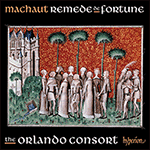With Hope’s songs having effected the full return of the Lover’s senses that had been stripped away by the end of his own complainte, the Lover notices for the first time that the garden is full of singing birds, and their song completes his recovery, leading him to compose a ballade,
Dame, de qui. The ballade’s form is similar to that of the preceding baladelle: both are three-stanza poems with a refrain in the last line, set to bipartite music, but the baladelle repeats both musical sections (aabb), while the ballade repeats only the first (aab). The formal similarity suggests that the Lover is modelling himself upon Hope, and the ballade’s textual content also shows how thoroughly the Lover has internalized Hope’s teaching: he expresses his current state of joy that derives from contemplating the lady and the hope he has of seeing her. In addition, the Lover is now employing polyphony, also seemingly following Hope’s model; the change from monophony to polyphony can thus be read as a kind of musical metaphor for the enchanted state of mind he enters when he is thinking like a true lover. In the
Remede’s earliest manuscript version the ballade is copied in two-voice polyphony: a cantus voice that sings the text, and a tenor. In later versions the number of polyphonic voices increases to four, significantly enriching the contrapuntal texture with the addition of triplum and contratenor (respectively above the existing cantus and tenor) parts.
from notes by Anne Stone © 2023


 Machaut: Songs from Remede de Fortune
Machaut: Songs from Remede de Fortune
